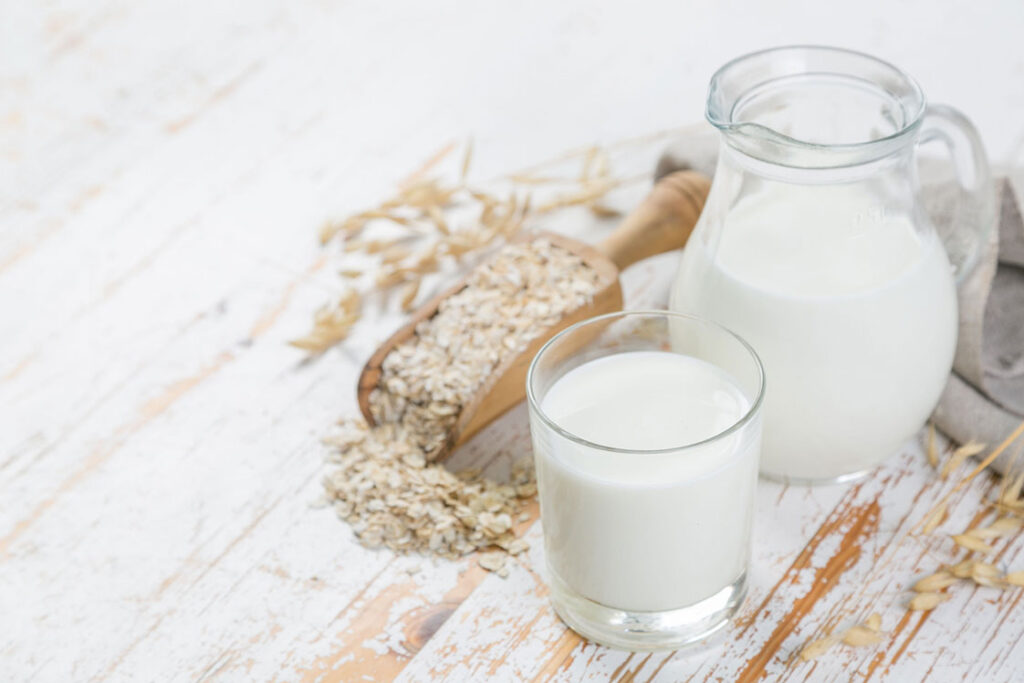Oat milk, like other non-dairy and vegan milks, is simply a strained mixture of oats and water. Some type of flavoring is usually added for sweetness and depth of flavor. Maple syrup or honey can be substituted for dates, or it can be made sweetener-free altogether. In recent years, non-dairy milks have been more popular than ever for those with lactose intolerance or those just seeking a healthier, more ethical alternative to dairy milk. A whopping 65% of the world population is estimated to be lactose intolerant, and up to 90% in certain ethnic groups. Oat milk has risen to the top in popularity amongst non-dairy milks in recent years for its neutral taste, creamy texture and sustainability in production.
Oat milk was first created in the 1980s in Sweden as an alternative for lactose-intolerant individuals. Many of the base ingredients of other non-dairy milks are not sustainable, especially for Nordic climates. For example, producing almond milk uses almost 1600 gallons of water to produce just a quart of final product. Oats use very little water by comparison and grow in a wide variety of climates, which also limits the carbon footprint required to transport it to the consumer.
Additionally, many people with nut allergies have a hard time finding a good dairy-free milk to use. Oat milk is not only a great dairy alternative, it’s also a good option for those with nut allergies. It’s creamier than some other non-dairy milks and is also naturally gluten-free. Oat milk is a great option for health reasons too, as it is naturally low in fat and may even help lower cholesterol. Oats are highly recommended by nutritionists for a few reasons. They’re 100% whole grain and rich with B vitamins, iron, calcium, magnesium and fiber.
You can use oat milk at home anywhere you would normally use dairy milk, like coffee, tea and smoothies. Because oat milk has a more neutral flavor than other non-dairy milks, it works great for cooking and baking.

How to Make Oat Milk
The most important tool for making oat milk at home is a quality blender. Ideally, a high-speed blender is best, but an immersion blender can work in a pinch.
Heat can cause the starches in the oats to coagulate, creating a slimy or gelatinous product. For best results, use ice-cold water and be very careful not to over blend, as this adds heat and releases more starches.
To make an even creamier oat milk, try substituting a cup of the oats in the recipe below with cashews or almonds. The natural fat in the nuts creates a creamy texture when pureed.
When finished straining, discard the oat pulp. You can save the oat pulp for use in baked goods, or in a face mask or bath.
Feel free to get creative with your oat milk. Try adding strawberries or blueberries to make a delicious berry flavored milk, or add cocoa powder for chocolate oat milk.
How to Strain Oat Milk
The texture of the final product is a matter of personal preference. Some like to see some flecks of oats in their milk, while others like a completely strained liquid.
Straining the oat milk can be done several different ways. You can find fine-meshed nut milk bags at many coffee shops and home goods stores that are made specifically for this purpose.
Coffee filters and paper towels will work but it will take a long time and a lot of stirring to get the liquid to pass through the material. A clean t-shirt or kitchen towel works best and is readily available.
Homemade Oat Milk
Makes 4 cups
Ingredients
1 cup rolled oats
3-4 pitted dates
4 cups very cold water
1 pinch salt (optional)
In the bowl of a blender, add oats, dates, water and salt. Cover with lid and blend on high for 10-20 seconds. Be careful not to over-blend, as this can cause sliminess.
Taste and adjust sweetness. Place a strainer over a bowl or measuring cup, then line with a very thin towel or clean t-shirt. Pour the mixture over the strainer. Use a spoon to encourage the liquid through the fabric.
Store in the refrigerator tightly sealed for up to 5 days. The oat milk may separate, so shake before consuming.
